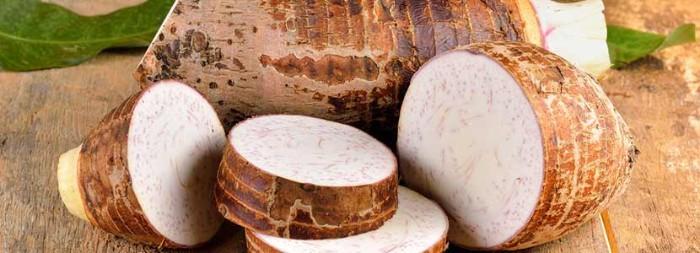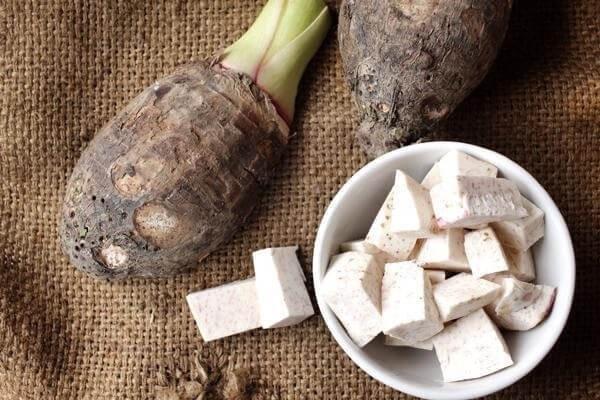Benefits of Taro Root
Feb 19, 2024 By Nancy Miller
Have you ever tasted the exotic flavor of taro root? As a tropical plant native to Southeast Asia, Africa, and parts of Polynesia, this superfood has gained popularity due to its impressive nutritional benefits.
Taro root is an extremely nutrient-dense food packed with healthful vitamins and minerals to help keep your body functioning optimally.
From improved digestion and immune system support to helping reduce inflammation and protecting against chronic diseases, taro root offers a variety of amazing health advantages if consumed regularly.
This blog post will explore the benefits of adding taro root to your diet. Keep reading to learn more!
Explaining the Nutritional Benefits of Taro Root
Taro root is an important dietary staple for many cultures around the world. It’s a nutritious, starchy root vegetable with various potential health benefits.
One cup (132 grams) of cooked taro root contains 5 grams of fiber, 12% of your daily value (DV) of vitamin C, and 10% of your DV of potassium. It’s also a good source of folate, magnesium, manganese, and other essential vitamins and minerals.
Taro root is high in fiber, which can help improve digestion, regulate blood sugar levels and reduce cholesterol levels. Vitamin C helps boost immunity and keep skin healthy, while potassium may help lower blood pressure.
The folate found in taro root helps produce new cells and support fetal development during pregnancy. Additionally, magnesium is important for heart health, and manganese plays a role in bone formation and metabolism.
How to Cook and Prepare Taro Root for Delicious Meals

Taro root has a mildly sweet and nutty flavor that can be enjoyed in many dishes. It can be boiled, steamed, mashed or roasted, pureed into soups, or turned into chips. Additionally, taro root flour is becoming increasingly popular as an alternative to wheat flour and can be used to make pancakes, waffles, and other baked goods.
Overall, taro root is a delicious and nutritious vegetable that can be enjoyed in many dishes. Plus, it’s low in calories and fat, making it an excellent choice for those looking to improve their diet.
By incorporating this root vegetable into your meals, you can enjoy the many benefits of its nutrient-packed content.
Different Varieties of Taro Root
Taro root is available in many varieties, including purple, yellow, and white. Each variety has a slightly different flavor and texture and a range of nutritional benefits. The type of taro root you choose will depend on the dish you’re preparing.
Some varieties are better suited for steaming or roasting, while others are better suited for boiling or pureeing. Additionally, some varieties are more nutritionally dense than others and provide an even greater range of benefits.
No matter which variety you choose, taro root will be a delicious addition to your meals! It’s packed with essential vitamins, minerals, fiber, and other important nutrients that can help keep you healthy.
Plus, it’s a great alternative to more traditional starches like white potatoes and wheat flour. So, why not give taro root a try today?
Incorporating Taro Root into Your Diet for Maximum Benefit
Taro root is an excellent source of essential vitamins, minerals, fiber, and other important nutrients. To benefit from this versatile root vegetable most, incorporate it into your diet several times a week.
Start by boiling or steaming it in place of white potatoes or adding it to soups and stews. You can also mash it with butter and herbs for a delicious side dish or use taro root flour as an alternative to wheat flour in baked goods.
No matter how you prepare it, incorporating taro root into your diet can help ensure you get the vitamins, minerals, and other vital nutrients needed to stay healthy.
Tips on Storing and Preserving Taro Root for Longer Lasting Use

Taro root should always be stored in a cool, dry area to prevent spoilage. For maximum preservation, wrap the root vegetable in plastic wrap and store it in the refrigerator. It will last up to several weeks when stored properly.
You can also freeze taro root for longer-lasting use. Simply blanch the vegetable before freezing it to preserve its flavor and texture. When ready to eat, simply defrost the taro root in a bowl of cold water or put it in the refrigerator overnight.
Taro root is a versatile vegetable that can add delicious flavor and nutrition to any dish. Whether you steam, boil, or puree it, this nutrient-packed vegetable will surely be a hit in your kitchen!
With its many benefits and versatile uses, there’s no reason not to try it. So, why not add some taro root to your next meal? You won’t regret it!
Examples of Traditional Recipes Featuring Taro Root as a Main Ingredient
Taro root has long been featured in traditional recipes across the globe. Popular dishes include taro root curry, mashed taro root with herbs and spices, deep-fried taro chips, taro root and egg stir fry, and roasted taro with garlic.
These dishes are delicious and provide a range of nutritional benefits. Taro root is particularly high in iron, Vitamin C, magnesium, and other essential vitamins and minerals.
This makes it an excellent choice for those looking to improve their diet and get the most out of their meals.
Plus, taro root can be used as a substitute for traditional starches like white potatoes or wheat flour in many dishes, making it a great alternative for those following gluten-free or low-carb diets.
FAQs
What are the benefits of taro root?
Taro root is a nutrient-dense and versatile food with many potential health benefits. It’s rich in vitamins and minerals, including vitamins C, E, B6, manganese, copper, potassium, magnesium, and iron.
Taro root also contains dietary fiber that helps support healthy digestion by promoting regular bowel movements.
How can taro root improve my health?
Taro root can provide many potential health benefits. It is a great source of essential vitamins and minerals, including vitamin C, which helps to strengthen the immune system and fight infection; vitamin E, for its antioxidant properties; B6, which helps support healthy nerve function.
What are the nutritional benefits of taro root?
Taro root is a nutrient-dense food that offers many potential health benefits. It’s an excellent source of dietary fiber, which helps to support healthy digestion by promoting regular bowel movements.
Taro root also contains essential vitamins and minerals, including vitamins C, E, B6, manganese, copper, potassium, magnesium, and iron.
Conclusion
To conclude, taro root is a delicious, nutrient-dense superfood with impressive health benefits. It contains vitamins and minerals that can aid your body's various functions, promote digestion, help reduce inflammation, and protect against chronic diseases.
Taro root is also a versatile ingredient that can be added to many recipes for an extra nutritional boost.








